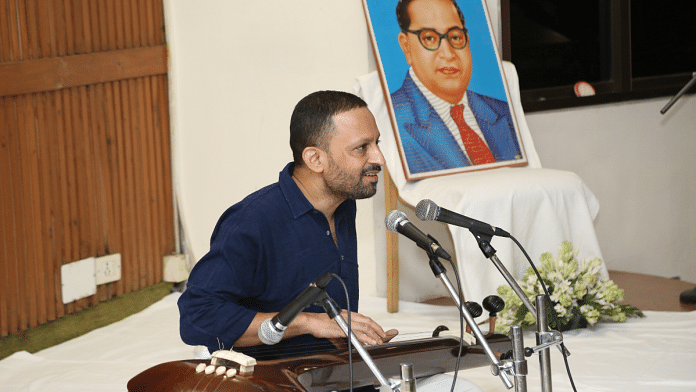New Delhi: Dhrupad, Dalit poetry, and Delhi’s privileged, well-heeled Nehruvian intellectuals came together Thursday at an innovative raga event in Delhi. It offered a journey starting from classical Tamil Nadu to Ambedkar’s Maharashtra to Ghalib’s streets of Delhi.
The occasion was the India International Centre’s ‘A Year of Poetry’ series, and anti-caste publisher S. Anand was the performer for the first edition. Anand, the co-founder of Delhi-based publishing house Navayana, also happens to be the student of Ustad Wasifuddin Dagar, a master of the dhrupad style of singing and the doyen of the famous Dagar gharana. In the program titled ‘A Lamp To the Sun’, Anand explored how Tamil Sangam-era poems, vachanas (Kannada), abhangs (Marathi), nirgun shabads (Braj), suttas (Pali) and ghazals find comfort in ragas.
It was unlike any other Delhi musical event. It was an act of resistance against purist insistence in music, literature, and performance.
The mood, tone, setting
At the event, a humble setting with a small stage, a few wooden chairs kept in front, and B.R. Ambedkar’s photo sitting in one corner on a white platform with some flowers around it defined the mood. The quiet hall soon started reverberating with the harmonious sounds coming from a tanpura played by S. Anand. The audience was swept into a poetic journey wrapped in ragas and multiple Indian traditions.
Anand started with a poem by Sempulapeyaneerar, a Sangam-era poet around 200 BCE, set in tune by Anand. Titled Like Pouring Rain Red with Earth, the poems described love and longing, and as Anand said, also reflected on how longing is beyond caste. His second poem, a 12th-century vachana by saint Basavanna and translated by A. K. Ramanujan, reflected on the faithfulness of a humble devotee. It translates to:
“The rich will make temples for Shiva,
What shall I, a poor man, do?”
“These vachanas are what constituted the language. These were the first utterances of the language. It was written by a community of poets belonging to different castes and professions. Brahmins also contributed,” Anand told the audience during the performance.
He then sang two abhangs — one by Sant Tukaram Maharaj and another by a 14th-century Dalit woman poet Sant Soyarabai. “I discovered this poem in Neela Bhagwat and Jerry Pinto’s book An Ant Who Swallowed the Sun, which is based on lesser-known Marathi women poet. Soyarabai writes her plight and complains against God whom she is not allowed to see because of her Dalit identity. She ends the poem with the phrase ‘Chokhyachi Mahari’, where Mahari was a caste slur, owning her Dalit identity ”, he said.
“Kiti kiti bolu deva, kiti karu aata heva (O God, how much more do I plead? The jealousy I must bear till you heed)” says the abhang by Soyarabai. Her helplessness turns into anger: “Ataa na dhari tumchi bheed, maaja nahi duuji chaad (I have no fear of you whatsoever, I have no fear of any whoever)”.
Also read: Ambedkar was latecomer in world of stamps where Nehru’s and Gandhi’s ‘could fill floors’
Going against tradition
Anand said that he got particularly drawn to abhangs after knowing that Ambedkar used to carry them in his newspapers despite the knowledge that they were sung in the praise of Vitthala – a popular god in Maharashtra who is considered to be the manifestation of Lord Vishnu.
Anand ended his performance with a nirgun shabad, a sutta and Ghalib’s famous ghazal “Na tha kuch toh khuda tha…” — composed in Raga Bhairavi and Khamboji, respectively (the sutta and ghazal).
Throughout his performance, Anand did not restrict himself to the purest style of dhrupad. “It is an Aalap pradhan style, but in today’s curated program based on poetry, I would not focus on only the aalaps and the traditional style of Dhrupad,” he told the audience at the beginning of the performance. The free-flow style of singing, infused with dhrupad, helped the audience connect with the emotions the poetry carried.
Anand mentioned that he stopped singing for 15 years, from 1999 to 2014, to fight the Brahmanical system prevailing in the Carnatic music tradition. He grew up in Hyderabad in a Tamil Brahmin family and learnt Carnatic music for a few years until he began questioning the poems he was singing. He started singing again in 2014 and in 2018 began learning dhrupad from Ustad Wasifuddin Dagar. Dhrupad is a more abstract style of singing that emphasises meaningless syllables to weave music. “I wondered why we were not singing great poetry from the anti-caste movement through Indian Ragas,” he said.
“In this land, where hierarchy, inequality, and cruelty thrive, two areas of unparalleled excellence have been open to all — music and poetry. Poetry, sometimes secular, sometimes clothed in the colours of belief, is mostly remembered and passed on as songs,” Anand added.
(Edited by Humra Laeeq)






